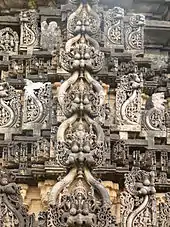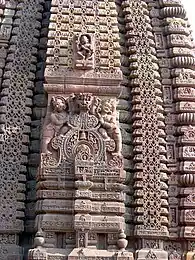
Kirtimukha (Sanskrit: कीर्तिमुख ,kīrtimukha, also kīrttimukha, a bahuvrihi compound translating to "glorious face") is the name of a swallowing fierce monster face with huge fangs, and gaping mouth, very common in the iconography of Hindu temple architecture in Nepal, India and Southeast Asia, and often also found in Buddhist architecture.[1]
Unlike other Hindu legendary creatures, for example the makara sea-monster, the kirtimukha is essentially an ornamental motif in art, which has its origin in a legend from the Skanda Purana and the Shiva Purana.
Origin and characteristics


The word mukha in Sanskrit refers to the face while kīrti means "fame, glory". The story of Kirtimukha begins when the asura king Jalandhara, who "by virtue of extraordinary austerities ... accumulated to himself irresistible powers."[2] In a burst of pride, he sent forth his messenger, the monster Rahu, whose main task is eclipsing the moon, to challenge Shiva. "The challenge ... was that Shiva should give up his shining jewel of a bride Parvati."[3] Shiva's immediate answer was to explode a tremendous burst of power from his third eye, which created a horrendous, emaciated, ravenous lion. A terrified Rahu sought Shiva's mercy, which Shiva agreed to. In order to feed the ravenous lion, Shiva suggested that the creature should feed on the flesh of its own feet and hands.[4] So, Kirtimukha willingly ate his body starting with its tail as per Shiva's order, stopping only when his face remained. Shiva, who was pleased with the result, gave it the name "glorious face", and declared that it should always be at the door of his temples. Thus, the Kirtimukha is a symbol of Shiva himself.
The Kirtimukha is often used as a motif surmounting the pinnacle of a temple or the image of a deity, especially in South Indian architecture. As Zimmer writes, "Kirtimukha serves primarily as an apotropaic demon-mask, a gruesome, awe-inspiring guardian of the threshold."[5]
This face is sometimes confused with another sculptural element, the lion face (Simhamukha).[6] However, in order to be a Kirtimukha it has to be engaged in swallowing, for the Kirtimukha is the figure of the "all consuming"[7]
This monstrous face with bulging eyes sits also as an embellishment over the lintel of the gate to the inner sanctum in many Hindu temples signifying the reabsorption that marks the entry into the temple.[8] In Dravidian architecture and elsewhere it tops gavaksha (kudu, nasi) motifs. Mostly it is only a face, indeed very often only the upper jaw and top of the face is visible, although in some places its arms are portrayed as well. The motif can also sometimes be found in Shiva's matted hair.[9]
Some authors have compared the Kirtimukha with the Greek myth of Ouroboros.[10]
Gallery
 Kirtimukha at Amruteshvara temple in Annigeri, Dharwad district, Karnataka state, India
Kirtimukha at Amruteshvara temple in Annigeri, Dharwad district, Karnataka state, India
 Kirtimukha at Kasi Visveshvara temple in Lakkundi, Gadag district, Karnataka state, India
Kirtimukha at Kasi Visveshvara temple in Lakkundi, Gadag district, Karnataka state, India

 Khmer Kirtimukha lintel at Vat Kralanh, Cambodia, Baphuon, Angkor style, 11th century
Khmer Kirtimukha lintel at Vat Kralanh, Cambodia, Baphuon, Angkor style, 11th century Kirthimukha at Siddhesvara temple in Haveri, Karnataka state, India
Kirthimukha at Siddhesvara temple in Haveri, Karnataka state, India


See also
Notes
- ↑ "Yalli and Mukha". Retrieved 2007-02-25.
- ↑ Heinrich Zimmer, Myths and Symbols in Indian Art and Civilisation, edited by Joseph Campbell. New York: Harper Torchbooks, 1946, p.175
- ↑ Ibid., p. 176
- ↑ Ibid., p. 180
- ↑ Ibid., p. 182
- ↑ Robert Beer. The Encyclopaedia of Tibetan Symbols and Motifs. ISBN 1-932476-10-5.
- ↑ Eckard Schleberger, Die indische Götterwelt
- ↑ Rohan Bastin, The Domain of Constant Excess: Plural Worship at the Munnesvaram Temples in Sri Lanka
- ↑ Zimmer, p. 182
- ↑ The Theosophical Society - The Predator, turning back on itself